Next class | Siguiente clase
Previous class | Clase anterior
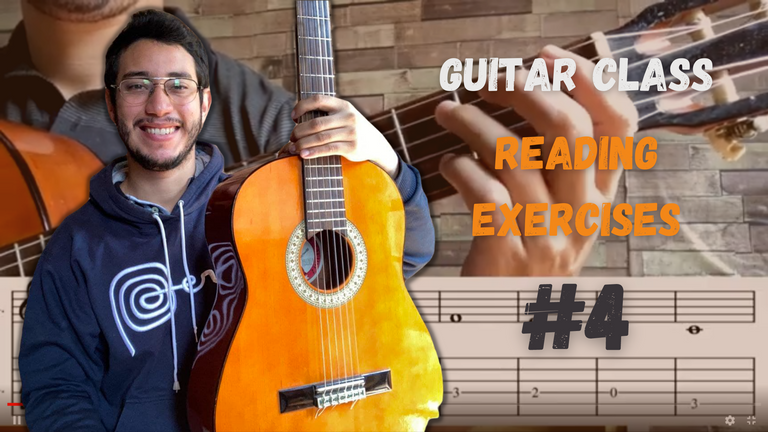
ESPAÑOL
¡Hola, clase! El día de hoy terminamos (al fin) con nuestros ejercicios de lectura. Disculpen, pero quería dejar un trabajo completo, dentro de mis limitaciones, para que pudieran practicar y adquirir los principios básicos de la lectura.
Pues sí, básicos.
Esto es así porque la habilidad para leer partituras o solfear se fortalece con la práctica continua y "dominarla" precisa de muchos años.
Pero no te preocupes, trataré de transcribir la mayor cantidad de ejercicios posibles en el futuro para que puedan progresar poco a poco :D
ENGLISH
Hello, class! Today we finished (at last) our reading exercises. Excuse me, but I wanted to leave complete work, within my limitations, so that you could practice and acquire the basics of reading.
Yes, the basics
This is because the ability to read sheet music or solfeggio is strengthened with continuous practice and "mastering" takes many years.
But don't worry, I will try to transcribe as many exercises as possible in the future so that you can progress little by little :D
Instrucciones
En este video he recopilado todos los ejercicios, así que bien podrías abordar esta clase de tres formas distintas:
Mira el video e intenta seguir todas las lecciones a la primera. Luego corrige los detalles con la información que encontrarás en esta descripción.
Repasa las instrucciones y asegúrate de tener todo claro, en cuanto al solfeo (lectura musical), la rítmica, la digitación, etc. Luego ve el video y practica.
Lee y mira el video simultáneamente. Repasa la descripción de un ejercicio y luego míralo en el video, y así hasta el final.
Por último, recuerda: Puedes dividir tu proceso de aprendizaje en tres objetivos perfección, velocidad y contenido. Selecciona solo dos de ellos mientras sacrificas otro. Por ejemplo, toca con velocidad y toda la lección, pero no perfecto. O toca todo completo y a la perfección, pero sin velocidad. Alterna este enfoque durante tu estudio y ten mucha paciencia.
Ahora, sí. Empecemos...
Instructions
In this video I have compiled all the exercises, so you might as well approach this class in three different ways:
Watch the video and try to follow all the lessons the first time. Then correct the details with the information you will find in this description.
Go through the instructions and make sure you are clear on solfège (music reading), rhythm, fingering, etc. Then watch the video and practice.
Read and watch the video simultaneously. Go through the description of an exercise and then watch it on the video, and so on until the end.
Finally, remember: You can divide your learning process into three goals perfection, speed and content. Select only two of them while sacrificing another. For example, play with speed and the whole lesson, but not perfect. Or play everything complete and perfect, but not at speed. Alternate this approach during your study and be very patient.
Ok, let's do it!
First Exercise | Primer Ejercicio
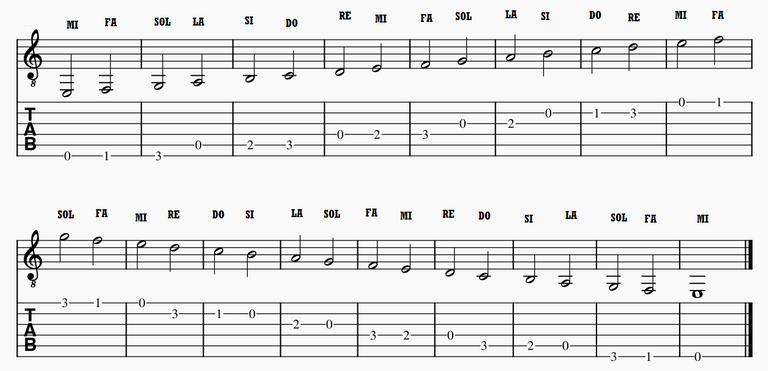
En este primer ejercicio haremos blancas de dos tiempos cada una. Empezaremos en la 6.ª cuerda al aire, o sea, la nota MI y llegaremos hasta el SOL en el tercer traste de la 1.ª cuerda para luego regresarnos.
De este modo recorreremos todas las cuerdas y haremos todas las notas "naturales" en la primera posición.
¿Qué son las notas naturales?
Son todas aquellas notas, digamos, que no tienen alteraciones. (Estos conceptos los profundizaremos en futuras entradas)
¿Cuál es la primera posición?
Es la posición que comienza a partir del primer traste. Desde esta los dedos pueden extenderse normalmente hasta el cuarto traste, correspondiendo cada uno con el que posee su mismo número.
In this first exercise, we will play half notes of two beats each. We will start on the 6th string in the air, that is, the note MI and we will go up to the SOL on the third fret of the 1st string and then go back.
In this way, we will go through all the strings and make all the "natural" notes in the first position.
What are natural notes?
They are all those notes, let's say, that have no accidentals. (We will go deeper into these concepts in future posts).
What is the first position?
It is the position that starts from the first fret. From this position, the fingers can normally extend up to the fourth fret, each one corresponding to the one with the same number.
Second Exercise | Segundo Ejercicio
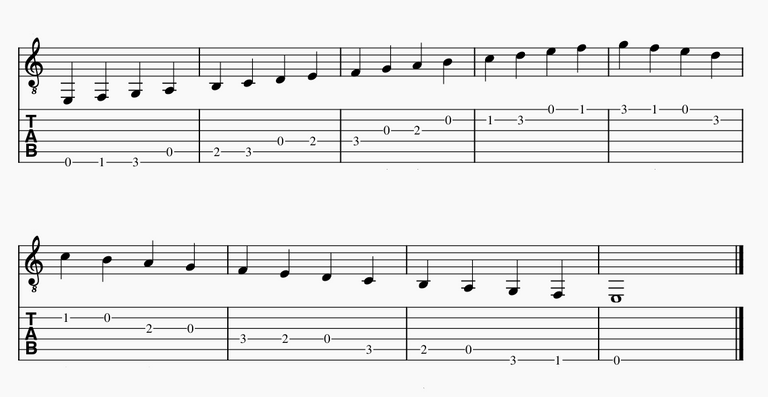
Muy bien, ahora haremos negras de un pulso cada una. El recorrido es el mismo, así que no deberías tener mayores dificultades. Pero si aún se te complica recuerda que puedes hacerlo siempre tan lento como necesites, pero asignándole un solo tempo a cada negra.
Recuerda alternar entre el índice y medio.
All right, now we'll do quartes notes of one pulse each. The path is the same, so you shouldn't have any difficulties. But if you still have trouble remember that you can always do it as slow as you need, but assigning only one tempo to each quarter note.
Remember to alternate between index and middle.
Third Exercise | Tercer Ejercicio
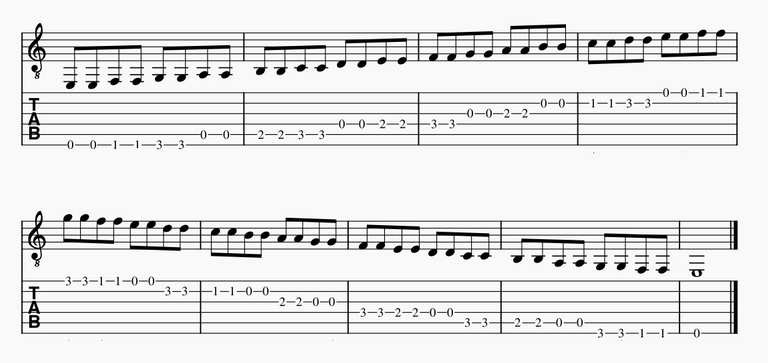
Las Corcheas
En esta ocasión, incluiremos una nueva figura. La corchea vale la mitad de la negra, por lo que ahora valdrá medio tiempo. De modo que en cada pulso habrá dos corcheas.
Para comprenderlo, haremos dos veces cada nota en cada pulso.
The Eighth Notes.
This time, we will include a new figure. The eighth note is worth half of the quarter note, so now it will be worth half a beat. So in each beat, there will be two eighth notes.
To understand this, we will play each note twice on each beat.
Fourth Exercise | Cuarto Ejercicio

Finalmente, haremos todas las notas en corcheas. Es más rápido por lo que tienes que ser ágil. Practica hasta que lo hagas con comodidad.
Finally, we will do all the notes in eighth notes. It's faster so you have to be agile. Practice until you are comfortable with it.
Así es como damos por terminado nuestros ejercicios de lectura. Sé que puede ser una lata, pero vuelve a estos cada vez que lo necesites. Para no hacerlos tan aburridos, intenta aumentar la velocidad un poco cada vez.
Nos vemos en una próxima clase :D
This is how we end our reading exercises. I know it can be a drag, but come back to these whenever you need to. To make them not so boring, try to increase the speed a little each time.
See you in the next class :D
Si te ha gustado este contenido, deja un comentario y tu voto. Compartelo con tus amigos y así me ayudas a llegar a más personas.
If you liked this content, leave a comment and your vote. Share it with your friends and help me reach more people.
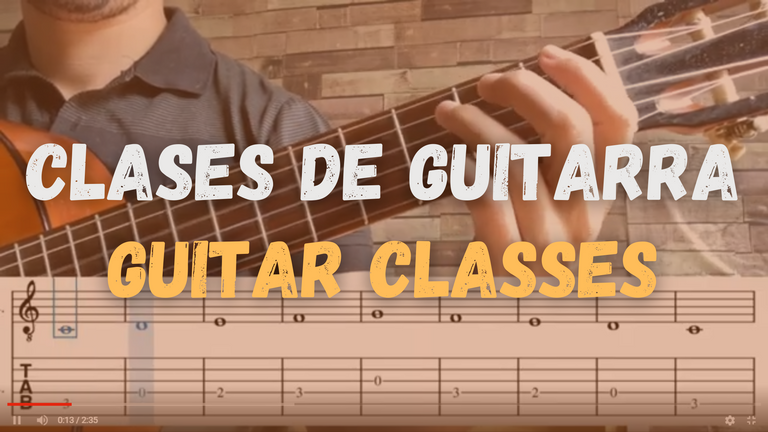
Congratulations @chentebass! You have completed the following achievement on the Hive blockchain and have been rewarded with new badge(s) :
Your next target is to reach 1500 upvotes.
You can view your badges on your board and compare yourself to others in the Ranking
If you no longer want to receive notifications, reply to this comment with the word
STOPTo support your work, I also upvoted your post!
Check out the last post from @hivebuzz:
Do you want to get involved? Do you want to support music and this project? Follow us to keep you updated and read our Introduction post!
🎶 Join us on our Discord Server! 🎵
Excelente contenido amigo ! las transcripciones son esenciales en la practica y teoría.
¡Muchas gracias, amigo! 😁
Sí, así es. Trataré en lo posible de poder transcribir todas las lecciones y canciones que vaya subiendo. Así voy refinando mi habilidad con los programas de escritura musical jaja
The rewards earned on this comment will go directly to the person sharing the post on Twitter as long as they are registered with @poshtoken. Sign up at https://hiveposh.com.